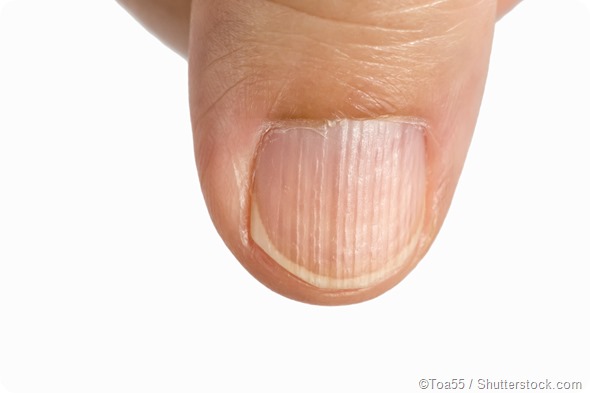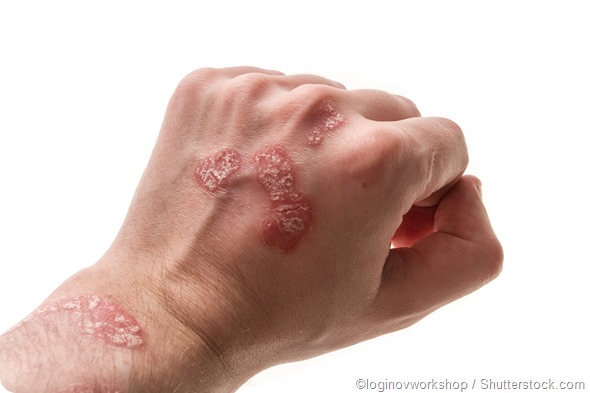Longitudinal ridging refers to the vertical raised lines present on the nails. Along with the ridging, the nails may also be discolored and thickened. A certain number of lines are typically found on all fingernails due to the basic aging process. However, they do not necessarily signal the presence of a health issue.

However, deeper ridges, discolored nails, and jagged edges of brittle nails may be symptomatic of other underlying conditions. Longitudinal ridging may be caused by a host of potential medical issues and might be a good reason to pay attention to the person’s general health and well-being.
Possible causes of longitudinal ridging can include:
Lichen planus
Lichen Planus is a chronic skin condition that affects approximately 0.1% to 4% of the population at some point in their lives. It causes longitudinal ridging in about 10% of people affected with the disorder. It is an autoimmune disease in which the inflammatory cells attack an unknown protein in the body.
Besides affecting the nails, it can cause a number of lesions on the skin as well as mucosal surfaces. It is also called “twenty nail dystrophy” if all the nails of the fingers and toes are affected.
Myxoid cyst
The myxoid cyst may also be called a mucous cyst, a digital ganglion cyst, or a digital synovial cyst. In this case, a cyst is formed in the skin around the nail and puts pressure on the nail's root. As a result, the nail develops a lateral groove extending outwards.
This kind of longitudinal ridging is caused due to the degeneration of the connective tissue on the top segment of the finger. Usually, once the cyst has been treated and healed, the longitudinal ridging also disappears once the nail outgrows it.
Darier’s disease
A genetic disease classified as a hereditary acantholytic dermatosis, Darier’s disease is inherited via an autosomal dominant gene. Thus a single parent can pass it on to the child. However, it is considered a benign disorder and may escape diagnosis in many people.
It is also often misdiagnosed as other skin conditions, but a skin biopsy is the best diagnostic tool to identify it. Longitudinal stripes of white and red tend to affect the nails of people with Darier’s disease. A v-shaped nick on the top of the nail is also typically characteristic of the disorder.
Psoriasis
This chronic skin condition is classified as an immune-mediated inflammatory disease, affecting approximately 4% of the world’s population. It affects the skin, causing red, scaly patches that can be itchy. In addition, the skin becomes very dry and may crack, causing fissures and bleeding.
The nails are also affected by discoloration and longitudinal ridging, and they become extremely brittle. There is no permanent cure and psoriasis flares up and reduces throughout the person’s life.

Alopecia areata
Alopecia refers to hair loss. In alopecia areata, a thinning of the hair results in a bald patch on the scalp. It can show up as a single big patch or a number of smaller ones. Eyebrows and eyelashes may also be affected.
Longitudinal ridging and pitting of the nails may appear in 15% of people who suffer from alopecia areata. It can be triggered by a viral infection, trauma, or hormonal change, and emotional and physical stress can possibly aggravate the preexisting condition.
Onychomycosis
Onychomycosis is essentially a fungal nail infection - it can be caused due to yeasts, molds, and dermatophytes. It is rarely seen in children but is found in older people. The condition may affect a single nail or more, with a higher likelihood of affecting toenails than fingernails.
It is usually seen in either the great toenail or the little toenail. A whitish-yellow stripe can be present on the side of the nail, and longitudinal ridging may be seen. Some cases may show complete destruction of the nail, while others may have partially crumbled or flaky nails.
Anemia
Anemia is a condition in which the red blood cells decrease, usually due to a deficiency of iron, vitamin B12, or folic acid. Iron deficiency alone may trigger skin problems. Associated effects can include brittle and fragile nails that may develop vertical ridges or lines. Supplements are the best way to handle the nutritional deficiency causing anemia.
Peripheral vascular disease
Peripheral Vascular Diseases (PVDs) are conditions affecting the circulation system. They affect the blood vessels, both arteries and veins. The vessels narrow due to arteriosclerosis or the building up of plaque within the vascular tubes. This constriction makes it difficult to maintain optimal levels of blood and oxygen flow to internal organs.
Organs usually affected by PVDs include the limbs and those placed below the stomach. The distance from the heart makes these blood vessels the peripheral vessels, hence the name of the disorder. The poor blood supply affects the nails and causes longitudinal ridging.
References
Further Reading